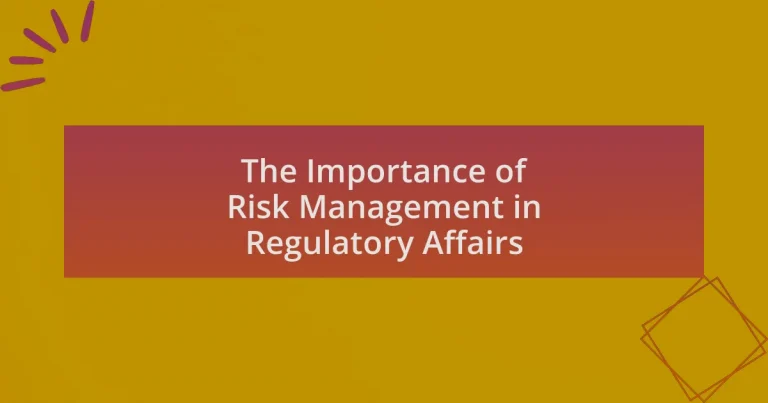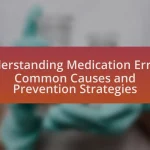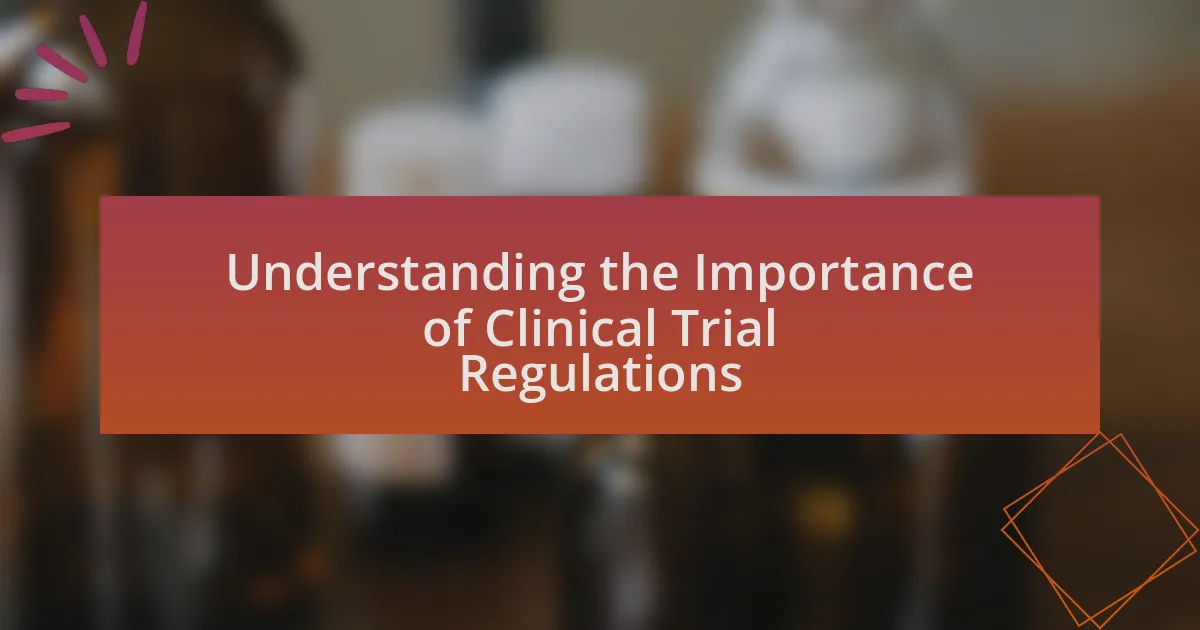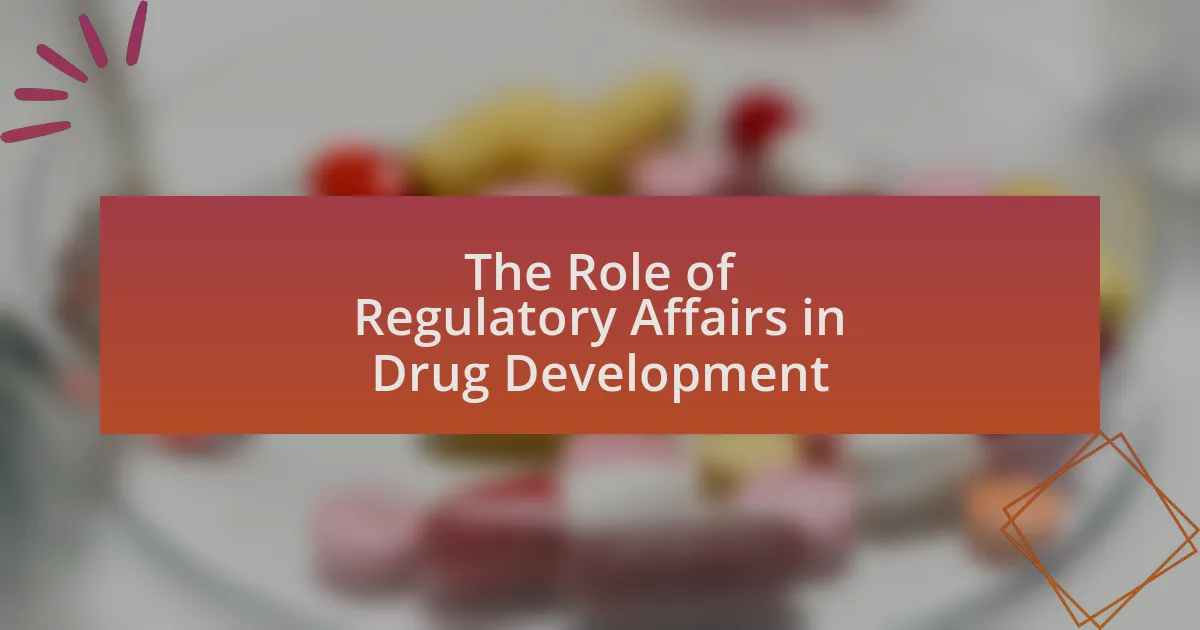Risk management is a critical component of regulatory affairs, ensuring compliance with laws and regulations while minimizing risks associated with product development and market entry. The article outlines the significance of effective risk management in preventing regulatory non-compliance, which can lead to financial penalties, product recalls, and reputational damage. Key risks include financial liabilities, operational disruptions, and legal challenges, while core principles such as risk identification, assessment, control, and communication guide regulatory decision-making. The article also discusses common frameworks, tools, and best practices for implementing risk management strategies, emphasizing the long-term benefits of enhanced organizational resilience and stakeholder confidence. Additionally, it addresses challenges in risk management implementation and highlights future trends influenced by technology and data analytics.
What is the Importance of Risk Management in Regulatory Affairs?
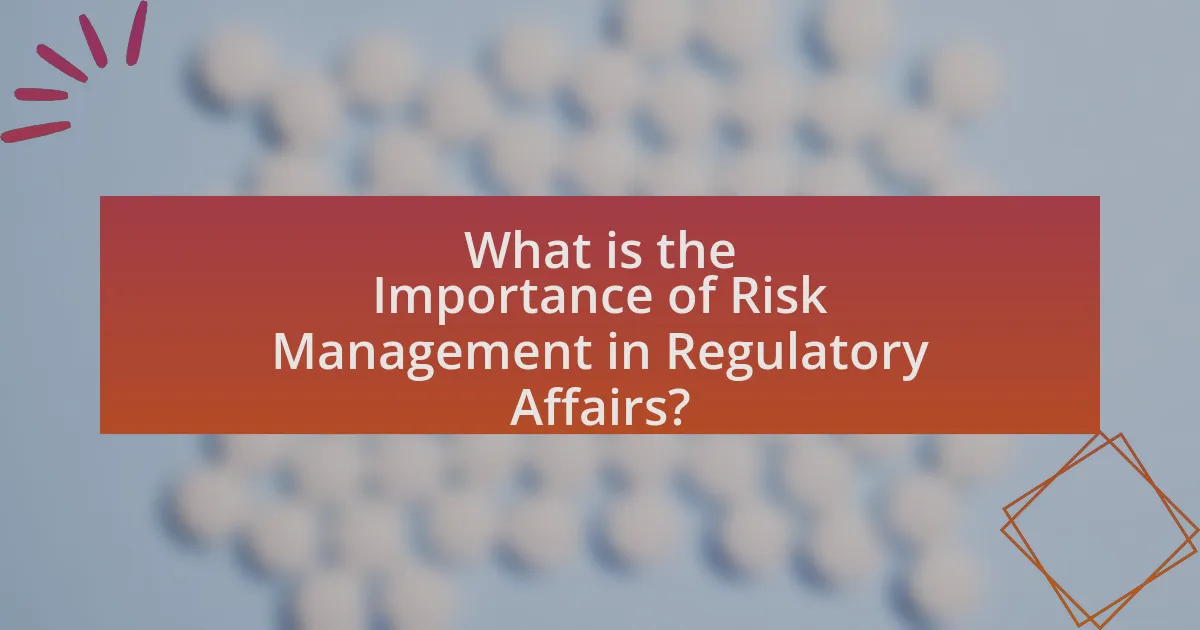
Risk management is crucial in regulatory affairs as it ensures compliance with laws and regulations while minimizing potential risks associated with product development and market entry. Effective risk management identifies, assesses, and mitigates risks that could lead to regulatory non-compliance, which can result in financial penalties, product recalls, or damage to reputation. For instance, the FDA emphasizes the importance of risk management in its guidance documents, highlighting that a proactive approach can enhance product safety and efficacy, ultimately protecting public health.
Why is risk management critical in regulatory affairs?
Risk management is critical in regulatory affairs because it ensures compliance with laws and regulations, thereby minimizing legal and financial penalties. Effective risk management identifies potential compliance issues early, allowing organizations to implement corrective actions proactively. For instance, companies in the pharmaceutical industry must adhere to stringent regulations set by agencies like the FDA; failure to manage risks associated with non-compliance can lead to costly fines and product recalls. Additionally, a study by the World Health Organization highlights that organizations with robust risk management frameworks are better positioned to navigate regulatory changes and maintain operational integrity.
What are the key risks associated with regulatory compliance?
The key risks associated with regulatory compliance include financial penalties, reputational damage, operational disruptions, and legal liabilities. Financial penalties can arise from non-compliance with regulations, leading to significant costs for organizations; for example, in 2020, the total fines imposed by regulatory bodies globally exceeded $10 billion. Reputational damage occurs when a company fails to meet compliance standards, resulting in loss of customer trust and market position. Operational disruptions can stem from the need to implement corrective actions or changes in processes to meet regulatory requirements, which can hinder productivity. Legal liabilities may arise from lawsuits or enforcement actions taken against organizations that do not adhere to regulations, potentially resulting in costly settlements or judgments.
How does risk management mitigate these compliance risks?
Risk management mitigates compliance risks by identifying, assessing, and prioritizing potential regulatory issues before they escalate. By implementing systematic processes, organizations can proactively address vulnerabilities, ensuring adherence to laws and regulations. For instance, regular audits and compliance training can significantly reduce the likelihood of violations, as evidenced by a study from the Association of Certified Fraud Examiners, which found that organizations with robust risk management frameworks experience 50% fewer compliance breaches. This proactive approach not only safeguards against penalties but also enhances overall operational integrity.
What are the core principles of risk management in regulatory affairs?
The core principles of risk management in regulatory affairs include risk identification, risk assessment, risk control, and risk communication. Risk identification involves recognizing potential risks that could impact compliance and safety in regulatory processes. Risk assessment evaluates the likelihood and impact of identified risks, prioritizing them based on their significance. Risk control encompasses strategies to mitigate or eliminate risks, ensuring adherence to regulatory standards. Finally, risk communication ensures that all stakeholders are informed about risks and the measures taken to address them, fostering transparency and accountability. These principles are essential for maintaining compliance and protecting public health and safety in regulated industries.
How do these principles guide regulatory decision-making?
Principles guide regulatory decision-making by providing a framework for assessing risks and benefits associated with regulatory actions. These principles ensure that decisions are based on scientific evidence, stakeholder input, and ethical considerations, which enhances transparency and accountability in the regulatory process. For instance, the precautionary principle emphasizes the need to take preventive action in the face of uncertainty, which can lead to more cautious regulatory measures when potential risks are identified. Additionally, principles such as proportionality ensure that the regulatory response is commensurate with the level of risk, thereby optimizing resource allocation and protecting public health effectively.
What frameworks are commonly used in risk management?
Commonly used frameworks in risk management include the ISO 31000, COSO ERM, and the NIST Risk Management Framework. ISO 31000 provides guidelines for risk management principles and processes, emphasizing a structured approach to managing risks across various sectors. COSO ERM focuses on enterprise risk management, integrating risk management with organizational strategy and performance. The NIST Risk Management Framework offers a structured process for integrating security and risk management into the system development lifecycle, particularly in federal information systems. These frameworks are widely recognized for their effectiveness in enhancing risk management practices across industries.
How does effective risk management impact organizational success?
Effective risk management significantly enhances organizational success by identifying, assessing, and mitigating potential threats that could hinder objectives. Organizations that implement robust risk management strategies are better equipped to navigate uncertainties, leading to improved decision-making and resource allocation. For instance, a study by the Institute of Risk Management found that organizations with effective risk management practices experience 20% higher profitability compared to those without such frameworks. This correlation underscores the importance of proactive risk management in fostering resilience and competitive advantage in the marketplace.
What are the long-term benefits of implementing risk management strategies?
Implementing risk management strategies leads to enhanced organizational resilience and improved decision-making over the long term. Organizations that adopt these strategies can better anticipate, mitigate, and respond to potential risks, which ultimately reduces the likelihood of financial losses and operational disruptions. For instance, a study by the Project Management Institute found that organizations with mature risk management practices are 2.5 times more likely to meet project objectives and stay within budget. This demonstrates that effective risk management not only safeguards assets but also contributes to achieving strategic goals, thereby fostering sustainable growth and stability in the regulatory landscape.
How does risk management enhance stakeholder confidence?
Risk management enhances stakeholder confidence by systematically identifying, assessing, and mitigating potential risks that could impact an organization’s objectives. This proactive approach demonstrates to stakeholders that the organization is committed to safeguarding their interests and maintaining operational stability. For instance, a study by the Project Management Institute found that organizations with mature risk management practices are 2.5 times more likely to meet their project objectives, which directly correlates to increased stakeholder trust and satisfaction. By effectively managing risks, organizations can provide stakeholders with assurance that they are prepared for uncertainties, thereby fostering a more reliable and transparent relationship.
What challenges are faced in implementing risk management in regulatory affairs?
Implementing risk management in regulatory affairs faces several challenges, including regulatory complexity, resource constraints, and the need for cross-functional collaboration. Regulatory complexity arises from the diverse and evolving nature of regulations across different jurisdictions, making it difficult for organizations to maintain compliance. Resource constraints, such as limited budgets and personnel, hinder the ability to effectively implement comprehensive risk management strategies. Additionally, the need for cross-functional collaboration among various departments, such as legal, compliance, and operations, can lead to communication barriers and misalignment in risk management objectives. These challenges can impede the effectiveness of risk management initiatives in ensuring regulatory compliance and safeguarding organizational interests.
How can organizations overcome these challenges?
Organizations can overcome challenges in regulatory affairs by implementing a robust risk management framework. This framework should include regular risk assessments, which help identify potential regulatory compliance issues early. For instance, a study by the Regulatory Affairs Professionals Society highlights that organizations employing proactive risk management strategies reduce compliance-related incidents by up to 30%. Additionally, continuous training and development of staff on regulatory changes ensure that employees are well-informed and capable of adapting to new requirements, further mitigating risks.
What specific tools and techniques are used in risk management?
Specific tools and techniques used in risk management include risk assessment matrices, risk registers, and quantitative risk analysis methods. Risk assessment matrices help prioritize risks based on their likelihood and impact, allowing organizations to focus on the most critical threats. Risk registers serve as comprehensive documentation of identified risks, their status, and mitigation strategies, facilitating ongoing monitoring and management. Quantitative risk analysis methods, such as Monte Carlo simulations, provide statistical insights into potential outcomes and their probabilities, enabling informed decision-making. These tools and techniques are essential for effective risk management in regulatory affairs, ensuring compliance and minimizing potential liabilities.
How do these tools facilitate better regulatory compliance?
Regulatory compliance tools facilitate better regulatory compliance by automating data collection and reporting processes, ensuring that organizations adhere to legal requirements efficiently. These tools streamline the tracking of regulatory changes and help maintain accurate records, which reduces the risk of non-compliance. For instance, software solutions can provide real-time updates on regulatory changes, allowing companies to adjust their practices promptly. According to a study by Deloitte, organizations that implement compliance management tools can reduce compliance costs by up to 30%, demonstrating the effectiveness of these tools in enhancing compliance efforts.
What best practices should organizations follow for effective risk management?
Organizations should follow a structured approach to risk management that includes identifying, assessing, and mitigating risks. Effective risk management practices involve establishing a risk management framework, conducting regular risk assessments, and implementing risk mitigation strategies. For instance, organizations can utilize tools like SWOT analysis to identify strengths, weaknesses, opportunities, and threats, which aids in understanding potential risks. Additionally, maintaining clear communication channels and fostering a risk-aware culture among employees enhances the overall effectiveness of risk management efforts. According to the ISO 31000 standard, organizations that adopt a systematic approach to risk management can improve decision-making and increase the likelihood of achieving objectives.
How can organizations continuously improve their risk management processes?
Organizations can continuously improve their risk management processes by implementing a systematic approach that includes regular assessments, stakeholder engagement, and the integration of advanced technologies. Regular assessments allow organizations to identify new risks and evaluate the effectiveness of existing controls, ensuring that risk management strategies remain relevant and effective. Engaging stakeholders, including employees and external partners, fosters a culture of risk awareness and encourages the sharing of insights that can lead to better decision-making. Additionally, integrating advanced technologies such as data analytics and artificial intelligence can enhance risk identification and monitoring capabilities, enabling organizations to respond proactively to emerging threats. These methods are supported by industry best practices, such as the ISO 31000 standard for risk management, which emphasizes the importance of continuous improvement in risk management frameworks.
What role does training play in enhancing risk management capabilities?
Training plays a crucial role in enhancing risk management capabilities by equipping individuals with the necessary skills and knowledge to identify, assess, and mitigate risks effectively. Through structured training programs, employees learn best practices, regulatory requirements, and analytical techniques that improve their decision-making processes in risk scenarios. For instance, organizations that implement comprehensive risk management training report a 30% reduction in compliance-related incidents, demonstrating the direct impact of training on risk management effectiveness.
What are the future trends in risk management within regulatory affairs?
Future trends in risk management within regulatory affairs include increased reliance on data analytics, enhanced collaboration between stakeholders, and the integration of artificial intelligence. Data analytics will enable organizations to identify and assess risks more effectively by leveraging large datasets, leading to more informed decision-making. Enhanced collaboration among regulatory bodies, industry players, and healthcare professionals will facilitate a more comprehensive understanding of risks and improve compliance strategies. The integration of artificial intelligence will streamline risk assessment processes, allowing for real-time monitoring and predictive analytics, which can significantly reduce the likelihood of regulatory non-compliance. These trends are supported by the growing emphasis on proactive risk management frameworks and the need for organizations to adapt to rapidly changing regulatory environments.
How will technology influence risk management practices?
Technology will significantly enhance risk management practices by enabling real-time data analysis and predictive modeling. Advanced analytics tools allow organizations to identify potential risks more accurately and swiftly, leading to informed decision-making. For instance, the integration of artificial intelligence in risk assessment can analyze vast datasets to uncover patterns and trends that human analysts might overlook. According to a report by Deloitte, companies that leverage technology in risk management can reduce operational risks by up to 30%, demonstrating the effectiveness of these technological advancements in improving risk mitigation strategies.
What practical steps can organizations take to strengthen their risk management strategies?
Organizations can strengthen their risk management strategies by implementing a comprehensive risk assessment framework. This involves identifying potential risks, analyzing their impact, and prioritizing them based on likelihood and severity. For instance, a study by the Risk Management Society found that organizations employing structured risk assessments reported a 30% reduction in unexpected incidents. Additionally, organizations should establish a risk management culture by training employees on risk awareness and response protocols, which enhances overall preparedness. Regularly reviewing and updating risk management policies ensures they remain relevant and effective, as evidenced by the fact that organizations that conduct annual reviews are 40% more likely to mitigate risks effectively. Finally, leveraging technology, such as risk management software, can streamline the monitoring and reporting processes, providing real-time insights into risk exposure.
